ASA and Catalyst 3750X Series Switch TrustSec Configuration Example and Troubleshoot Guide
Available Languages
Contents
Introduction
This article describes how to configure Cisco TrustSec (CTS) on the Cisco Secure Adaptive Security Appliance (ASA) and a Cisco Catalyst 3750X Series switch (3750X).
In order to learn the mapping between Security Group Tags (SGTs) and IP addresses, the ASA uses the SGT Exchange Protocol (SXP). Then, Access Control Lists (ACLs) based on SGT are used in order to filter the traffic. The 3750X downloads Role-Based Access Control List (RBACL) policies from the Cisco Identity Services Engine (ISE), and filters traffic based on them. This article details the packet level in order to describe how the communication operates and the expected debugs.
Prerequisites
Requirements
Cisco recommends that you have basic knowledge of these topics:
- CTS Components
- CLI Configuration of ASA and Cisco IOS®
Components Used
The information in this document is based on these software and hardware versions:
- Cisco ASA software, Versions 9.1 and later
- Microsoft (MS) Windows 7 and MS Windows XP
- Cisco 3750X software, Versions 15.0 and later
- Cisco ISE software, Versions 1.1.4 and later
The information in this document was created from the devices in a specific lab environment. All of the devices used in this document started with a cleared (default) configuration. If your network is live, make sure that you understand the potential impact of any command.
Configure
Network Diagram
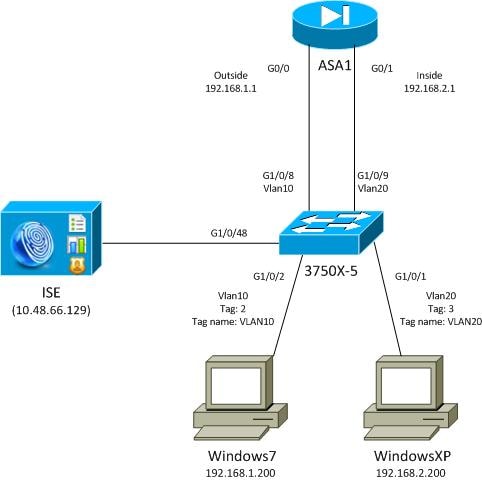
Traffic Flow
Here is the traffic flow:
- The 3750X is configured on G1/0/1 and G1/0/2 for port authentication.
- The ISE is used as the Authentication, Authorization, and Accounting (AAA) server.
- MAC Address Bypass (MAB) is used for authentication for MS Windows 7.
- IEEE 802.1x is used for MS Windows XP in order to demonstrate that it does not matter which authentication method is used.
After successful authentication, the ISE returns the SGT, and the 3750X binds that tag to the authentication session. The switch also learns the IP addresses of both stations with the ip device tracking command. The switch then uses SXP in order to send the mapping table between the SGT and the IP address to the ASA. Both MS Windows PCs have a default routing that points to the ASA.
After the ASA receives traffic from the IP address that is mapped to the SGT, it is able to use the ACL based on the SGT. Also, when you use 3750X as a router (default gateway for both MS Windows stations), it is able to filter the traffic based on policies downloaded from the ISE.
Here are the steps for configuration and verification, each of which is detailed in its own section later in the document:
- Port authentication with the ip device tracking command on the 3750X
- ISE configuration for authentication, SGT, and Security Group Access Control List (SGACL) policies
- CTS configuration on the ASA and the 3750X
- Protected Access Credential (PAC) provisioning on the 3750X (automatic) and the ASA (manual)
- Environment refresh on the ASA and the 3750X
- Port authentication verification and enforcement on the 3750X
- Policy refresh on the 3750X
- SXP exchange (the ASA as listener, and the 3750X as speaker)
- Traffic filtering on the ASA with SGT ACL
- Traffic filtering on the 3750X with policies downloaded from the ISE
Configurations
Port Authentication with the ip device tracking Command on the 3750X
This is the typical configuration for 802.1x or MAB. RADIUS Change of Authorization (CoA) is needed only when you use active notification from the ISE.
aaa new-model
aaa authentication dot1x default group radius
aaa authorization network default group radius
aaa authorization network ise group radius
aaa accounting dot1x default start-stop group radius
!Radius COA
aaa server radius dynamic-author
client 10.48.66.129 server-key cisco
server-key cisco
ip device tracking
interface GigabitEthernet1/0/1
description windowsxp
switchport mode access
authentication order mab dot1x
authentication port-control auto
mab
dot1x pae authenticator
spanning-tree portfast
!
interface GigabitEthernet1/0/2
description windows7
switchport mode access
authentication order mab dot1x
authentication port-control auto
mab
dot1x pae authenticator
spanning-tree portfast
radius-server host 10.48.66.129 pac key cisco
radius-server host 10.48.66.129 auth-port 1812
radius-server vsa send accounting
radius-server vsa send authentication
ISE Configuration for Authentication, SGT, and SGACL Policies
The ISE must have both network devices configured under Administration > Network Devices:

For MS Windows 7, which uses MAB authentication, you must create Endpoint Identity (MAC address) under Administration > Identity Management > Identities > Endpoints:
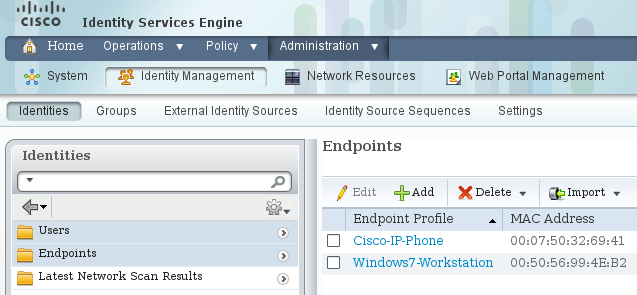
For MS Windows XP, which uses 802.1x authentication, you must create a User Identity (username) under Administration > Identity Management > Identities > Users:

The username cisco is used. Configure MS Windows XP for Extensible Authentication Protocol-Protected EAP (EAP-PEAP) with these credentials.
On the ISE, the default authentication policies are used (do not change this). The first is the policy for MAB authentication, and the second is 802.1x:
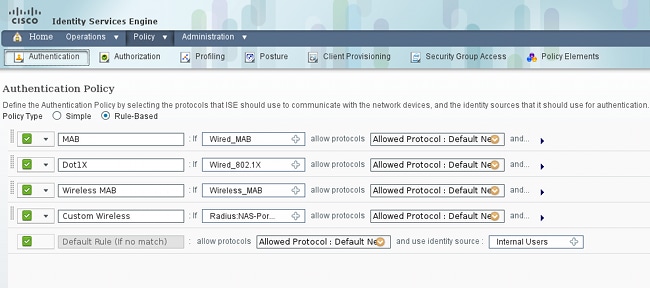
In order to configure authorization policies, you must define authorization profiles under Policy > Results > Authorization > Authorization Profiles. The VLAN10-Profile with Downloadable ACL (DACL), which allows for all traffic, is used for the MS Windows 7 profile:
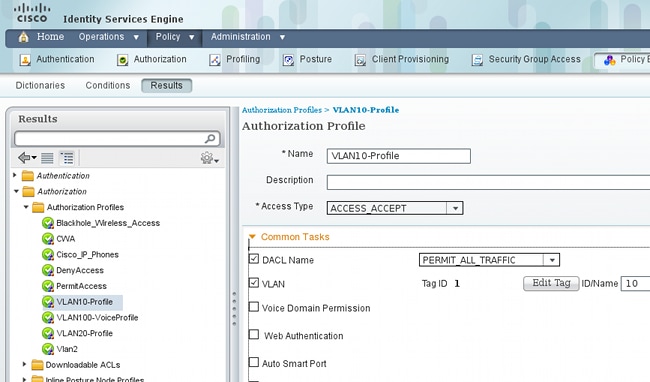
A similar configuration, VLAN20-Profile, is used for MS Windows XP with the exception to VLAN number (20).
In order to configure the SGT groups (tags) on ISE, navigate to Policy > Results > Security Group Access > Security Groups.
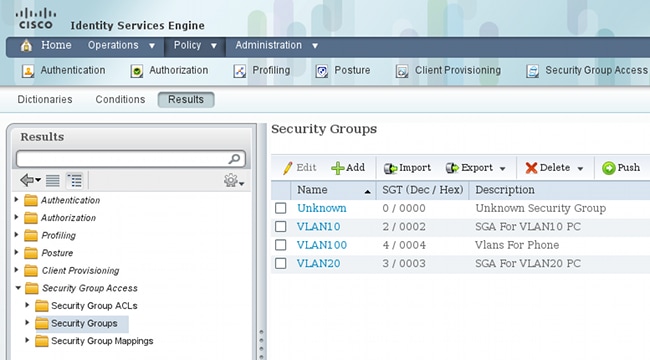
In order to create the SGACL to permit Internet Control Message Protocol (ICMP) traffic, navigate to Policy > Results > Security Group Access > Security Group ACLs:
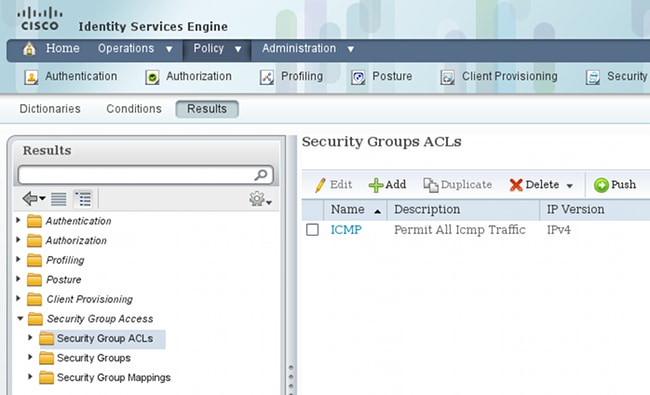
In order to create policies, navigate to Policy > Security Group Access > Egress Policy. For traffic between VLAN10 and the unknown VLAN or VLAN10 or VLAN20, the ICMP ACL is used (permit icmp):
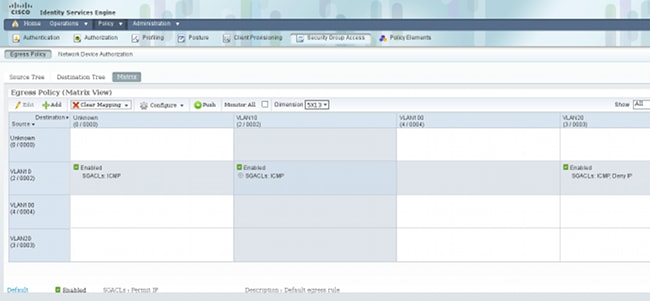
In order to set authorization rules, navigate to Policy > Authorization. For MS Windows 7 (specific MAC address), VLAN10-Profile is used, returning VLAN10 and DACL, and the security profile VLAN10 with the SGT named VLAN10. For MS Windows XP (specific username), VLAN20-Profile is used, returning VLAN 20 and DACL, and the security profile VLAN20 with the SGT named VLAN20.
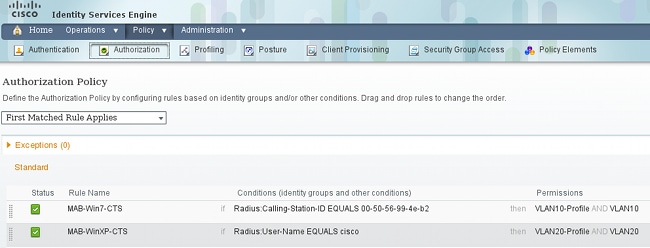
Finish the switch and ASA configuration in order for them to accept the SGT RADIUS attributes.
CTS Configuration on the ASA and the 3750X
You must configure basic CTS settings. On the 3750X, you must indicate from which server policies should be downloaded:
aaa authorization network ise group radius
cts authorization list ise
On the ASA, only the AAA server is needed along with CTS that points to that server:
aaa-server ISE protocol radius
aaa-server ISE (mgmt) host 10.48.66.129
key *****
cts server-group ISE
PAC Provisioning on the 3750X (Automatic) and the ASA (Manual)
Each device in the CTS cloud must authenticate to the authentication server (ISE) in order to be trusted by other devices. It uses the Extensible Authentication Protocol-Flexible Authentication via Secure Protocol (EAP-FAST) method (RFC 4851) for this. This method requires you to have PAC delivered out-of-band. This process is also called phase0, and is not defined in any RFC. PAC for EAP-FAST has a similar role as the certificate for Extensible Authentication Protocol-Transport Layer Security (EAP-TLS). PAC is used in order to establish a secure tunnel (phase1), which is needed for authentication in phase2.
PAC Provisioning on the 3750X
The 3750X supports automatic PAC provisioning. A shared password is used on the switch and the ISE in order to download PAC. That password and ID must be configured on the ISE under Administration > Network Resources > Network Devices. Select the switch, and expand the Advanced TrustSec Settings section in order to configure:

In order to have PAC use these credentials, enter these commands:
bsns-3750-5#cts credentials id 3750X password ciscocisco
bsns-3750-5#show cts pacs
AID: C40A15A339286CEAC28A50DBBAC59784
PAC-Info:
PAC-type = Cisco Trustsec
AID: C40A15A339286CEAC28A50DBBAC59784
I-ID: 3750X
A-ID-Info: Identity Services Engine
Credential Lifetime: 08:04:40 UTC Sep 25 2013
PAC-Opaque: 000200B00003000100040010C40A15A339286CEAC28A50DBBAC59784000600940003
010094F559DAE0C837D7847F2454CAD7E80B0000001351C8235900093A803D7D427BFB5C6F0FBBDF
7EDF0818C58FECF97F8BDECF1B115FB0240260ADA8C96A46AA2A64C9EA2DB51E0E886768CA2D133D
2468D9D33339204BAA7E4CA2DE8E37FF1EB5BCB343408E9847998E301C26DDC6F91711F631A5B4C7
C2CB09EAB028630A3B22901FE3EF44F66FD019D09D2C46D92283
Refresh timer is set for 2y24w
PAC Provisioning on the ASA
The ASA supports only manual PAC provisioning. This means that you must generate it manually on the ISE (in Network Devices/ASA):

Then the file must be installed (for example, with FTP):
bsns-asa5510-17(config)# cts import-pac ftp://ftp:ftp@10.147.25.80/ASA.pac
password ciscocisco
!PAC Imported Successfully
bsns-asa5510-17(config)# show cts pac
PAC-Info:
Valid until: Jul 04 2014 13:33:02
AID: c40a15a339286ceac28a50dbbac59784
I-ID: ASA
A-ID-Info: Identity Services Engine
PAC-type: Cisco Trustsec
PAC-Opaque:
000200a80003000100040010c40a15a339286ceac28a50dbbac597840006008c000301
0003d64668f2badc76e251683394b3d5690000001351d15dd900093a8044df74b2b71f
e667d7b908db7aeea3229e61462bdb70f46580bef9425011126bbf6c2f4212ccdacf08
c01ddbc7608c3a1ddeb996ba9bfbd1b207281e3edc9ff61b9e800f225dc3f82bd5f794
7e0a86bee8a3d437af93f54e61858bac877c58d3fe0ec6be54b4c75fad23e1fd
Environment Refresh on the ASA and the 3750X
At this stage, both devices have PAC installed correctly and automatically start to download the ISE environment data. This data is basically tag numbers and their names. In order to trigger an environment refresh on the ASA, enter this command:
bsns-asa5510-17# cts refresh environment-data
In order to verify it on the ASA (unfortunately you cannot see the specific SGT tags/names, but it is verified later), enter this command:
bsns-asa5510-17(config)# show cts environment-data
CTS Environment Data
====================
Status: Active
Last download attempt: Successful
Environment Data Lifetime: 86400 secs
Last update time: 05:05:16 UTC Apr 14 2007
Env-data expires in: 0:23:56:15 (dd:hr:mm:sec)
Env-data refreshes in: 0:23:46:15 (dd:hr:mm:sec)
In order to verify it on 3750X, trigger an environment refresh with this command:
bsns-3750-5#cts refresh environment-data
In order to verify the results, enter this command:
bsns-3750-5#show cts environment-data
CTS Environment Data
====================
Current state = COMPLETE
Last status = Successful
Local Device SGT:
SGT tag = 0-01:Unknown
Server List Info:
Installed list: CTSServerList1-0001, 1 server(s):
*Server: 10.48.66.129, port 1812, A-ID C40A15A339286CEAC28A50DBBAC59784
Status = ALIVE flag(0x11)
auto-test = TRUE, keywrap-enable = FALSE, idle-time = 60 mins,
deadtime = 20 secs
Security Group Name Table:
0001-60 :
0-47:Unknown
2-47:VLAN10
3-47:VLAN20
4-47:VLAN100
Transport type = CTS_TRANSPORT_IP_UDP
Environment Data Lifetime = 86400 secs
Last update time = 05:33:49 UTC Thu Apr 7 2011
Env-data expires in 0:16:46:50 (dd:hr:mm:sec)
Env-data refreshes in 0:16:46:50 (dd:hr:mm:sec)
Cache data applied = NONE
State Machine is running
This shows that all tags and corresponding names are correctly downloaded.
Port Authentication Verification and Enforcement on the 3750X
After the 3750X has the environment data, you must verify that the SGTs are applied to authenticated sessions.
In order to verify if MS Windows 7 is authenticated correctly, enter this command:
bsns-3750-5#show authentication sessions interface g1/0/2
Interface: GigabitEthernet1/0/2
MAC Address: 0050.5699.4eb2
IP Address: 192.168.1.200
User-Name: 00-50-56-99-4E-B2
Status: Authz Success
Domain: DATA
Security Policy: Should Secure
Security Status: Unsecure
Oper host mode: single-host
Oper control dir: both
Authorized By: Authentication Server
Vlan Policy: 10
ACS ACL: xACSACLx-IP-PERMIT_ALL_TRAFFIC-51134bb2
SGT: 0002-0
Session timeout: N/A
Idle timeout: N/A
Common Session ID: C0A80001000001002B67334C
Acct Session ID: 0x00000179
Handle: 0x94000101
Runnable methods list:
Method State
mab Authc Success
dot1x Not run
The output shows that VLAN10 is used along with the SGT 0002 and DACL permitting for all traffic.
In order to verify if MS Windows XP is authenticated correctly, enter this command:
bsns-3750-5#sh authentication sessions interface g1/0/1
Interface: GigabitEthernet1/0/1
MAC Address: 0050.5699.4ea1
IP Address: 192.168.2.200
User-Name: cisco
Status: Authz Success
Domain: DATA
Security Policy: Should Secure
Security Status: Unsecure
Oper host mode: multi-auth
Oper control dir: both
Authorized By: Authentication Server
Vlan Policy: 20
ACS ACL: xACSACLx-IP-PERMIT_ALL_TRAFFIC-51134bb2
SGT: 0003-0
Session timeout: N/A
Idle timeout: N/A
Common Session ID: C0A80001000000FE2B67334C
Acct Session ID: 0x00000177
Handle: 0x540000FF
Runnable methods list:
Method State
dot1x Authc Success
mab Not run
The output shows that VLAN 20 is used along with the SGT 0003 and DACL permitting for all traffic
IP addresses are detected with the ip device tracking functionality. The DHCP switch should be configured for dhcp snooping. Then, after the snooping DHCP response, it learns the IP address of the client. For a statically-configured IP address (like in this example), the arp snooping functionality is used, and a PC must send any packet for the switch to be able to detect its IP address.
For device tracking, a hidden command might be needed in order to activate it on ports:
bsns-3750-5#ip device tracking interface g1/0/1
bsns-3750-5#ip device tracking interface g1/0/2
bsns-3750-5#show ip device tracking all
IP Device Tracking = Enabled
IP Device Tracking Probe Count = 3
IP Device Tracking Probe Interval = 30
IP Device Tracking Probe Delay Interval = 0
-----------------------------------------------------------------------
IP Address MAC Address Vlan Interface STATE
-----------------------------------------------------------------------
192.168.1.200 0050.5699.4eb2 10 GigabitEthernet1/0/2 ACTIVE
192.168.2.200 0050.5699.4ea1 20 GigabitEthernet1/0/1 ACTIVE
Total number interfaces enabled: 2
Enabled interfaces:
Gi1/0/1, Gi1/0/2
Policy Refresh on the 3750X
The 3750X (unlike the ASA) can download policies from the ISE. Before it downloads and enforces a policy, you must enable it with these commands:
bsns-3750-5(config)#cts role-based enforcement
bsns-3750-5(config)#cts role-based enforcement vlan-list 1-1005,1007-4094
If you do not enable it, the policy is downloaded, but not installed and not used for enforcement.
In order to trigger a policy refresh, enter this command:
bsns-3750-5#cts refresh policy
Policy refresh in progress
In order to verify that the policy is downloaded from the ISE, enter this command:
bsns-3750-5#show cts role-based permissions
IPv4 Role-based permissions default:
Permit IP-00
IPv4 Role-based permissions from group 2:VLAN10 to group Unknown:
ICMP-20
IPv4 Role-based permissions from group 2:VLAN10 to group 2:VLAN10:
ICMP-20
IPv4 Role-based permissions from group 2:VLAN10 to group 3:VLAN20:
ICMP-20
Deny IP-00
The output shows that only the necessary part of the policy is downloaded.
In the CTS cloud, the packet contains the SGT of the source host, and enforcement is made at the destination device. This means that the packet is forwarded from the source to the last device, which is connected directly to the destination host. That device is the point of enforcement, since it knows the SGTs of its directly-connected hosts, and knows if the incoming packet with a source SGT should be permitted or denied for the specific destination SGT.
This decision is based on policies downloaded from the ISE.
In this scenario, all the policies are downloaded. However, if you clear the MS Windows XP authentication session (SGT=VLAN20), then there is no need for the switch to download any policy (row) that corresponds to VLAN20, because there are no more devices from that SGT connected to the switch.
The Advanced (Troubleshooting) section explains how the 3750X decides which policies should be downloaded with an examination of the packet level.
SXP Exchange (the ASA as Listener, and the 3750X as Speaker)
The ASA does not support SGT. All the frames with SGT are dropped by the ASA. That is why the 3750X cannot send SGT-tagged frames to the ASA. Instead, SXP is used. This protocol allows the ASA to receive information from the switch about mapping between the IP addresses and SGT. With that information, the ASA is able to map IP addresses to SGTs and make a decision based on SGACL.
In order to configure the 3750X as a speaker, enter these commands:
cts sxp enable
cts sxp default source-ip 192.168.1.10
cts sxp default password cisco
cts sxp connection peer 192.168.1.1 password default mode local
In order to configure the ASA as a listener, enter these commands:
cts sxp enable
cts sxp default password *****
cts sxp default source-ip 192.168.1.1
cts sxp connection peer 192.168.1.10 password default mode local listener
In order to verify that the ASA received the mappings, enter this command:
bsns-asa5510-17# show cts sxp sgt-map ipv4 detail
Total number of IP-SGT mappings : 2
Total number of IP-SGT mappings shown: 2
SGT : 2:VLAN10
IPv4 : 192.168.1.200
Peer IP : 192.168.1.10
Ins Num : 1
Status : Active
Seq Num : 49
SGT : 3:VLAN20
IPv4 : 192.168.2.200
Peer IP : 192.168.1.10
Ins Num : 1
Status : Active
Seq Num : 39
Now, when the ASA receives the incoming packet with the source IP address 192.168.1.200, it is able to treat it as if it comes from SGT=2. For the source IP address 192.168.200.2, it is able to treat it as if it comes from SGT=3. The same applies for the destination IP address.
Traffic Filtering on ASA with SGT ACL
Here is a check of the ASA configuration:
interface Ethernet0/0
nameif outside
security-level 0
ip address 192.168.1.1 255.255.255.0
!
interface Ethernet0/1
nameif inside
security-level 100
ip address 192.168.2.1 255.255.255.0
An ACL is created and applied to the inside interface. It allows for all ICMP traffic from SGT=3 to SGT=2 (called VLAN10):
access-list inside extended permit icmp security-group tag 3 any security-group
name VLAN10 any
access-group inside in interface inside
If you ping from MS Windows XP with a source IP address of 192.168.2.200 (SGT=3) to MS Windows 7 with an IP address of 192.168.1.200 (SGT=2), the ASA builds a connection:
%ASA-6-302020: Built outbound ICMP connection for faddr 192.168.1.200/0
(2:VLAN10) gaddr 192.168.2.200/512 laddr 192.168.2.200/512(3:VLAN20)
When you attempt the same with Telnet, the traffic is blocked:
Deny tcp src inside:192.168.2.200/2478(3:VLAN20) dst outside:192.168.1.200/23
(2:VLAN10) by access-group "inside"
There are more configuration options on the ASA. It is possible to use both a security tag and an IP address for both the source and the destination. This rule allows ICMP echo traffic from SGT tag = 3 and IP address 192.168.2.200 to the SGT tag named VLAN10 and the destination host address 192.168.1.200:
access-list inside extended permit icmp security-group tag 3 host 192.168.2.200
security-group name VLAN10 host 192.168.1.200 echo
This can also be achieved with object groups:
object-group security SGT-VLAN-10
security-group name VLAN10
object-group security SGT-VLAN-20
security-group tag 3
object-group network host1
network-object host 192.168.1.200
object-group network host2
network-object host 192.168.2.200
object-group service my-icmp-echo
service-object icmp echo
access-list inside extended permit object-group my-icmp-echo
object-group-security SGT-VLAN-20 object-group host2 object-group-security
SGT-VLAN-10 object-group host1
Traffic Filtering on the 3750X with Policies Downloaded from the ISE (RBACL)
It is also possible to define local policies on the switch. However, this example presents policies downloaded from the ISE. Policies defined on the ASA are allowed to use both IP addresses and SGTs (and the username from Active Directory) in one rule. Policies defined on the switch (both local and from the ISE) allow only for SGTs. If you need to use IP addresses in your rules, then filtering on the ASA is recommended.
ICMP traffic between MS Windows XP and MS Windows 7 is tested. For this, you must change the default gateway from the ASA to the 3750X on MS Windows. The 3750X has routing interfaces and is able to route the packets:
interface Vlan10
ip address 192.168.1.10 255.255.255.0
!
interface Vlan20
ip address 192.168.2.10 255.255.255.0
The policies are already downloaded from the ISE. In order to verify them, enter this command:
bsns-3750-5#show cts role-based permissions
IPv4 Role-based permissions default:
Permit IP-00
IPv4 Role-based permissions from group 2:VLAN10 to group Unknown:
ICMP-20
IPv4 Role-based permissions from group 2:VLAN10 to group 2:VLAN10:
ICMP-20
IPv4 Role-based permissions from group 2:VLAN10 to group 3:VLAN20:
ICMP-20
Deny IP-00
Traffic from VLAN10 (MS Windows 7) to VLAN20 (MS WindowsXP) is subjected to ICMP-20 ACL, which is downloaded from the ISE:
bsns-3750-5#show ip access-lists ICMP-20
Role-based IP access list ICMP-20 (downloaded)
10 permit icmp
In order to verify the ACL, enter this command:
bsns-3750-5#show cts rbacl
CTS RBACL Policy
================
RBACL IP Version Supported: IPv4
name = Deny IP-00
IP protocol version = IPV4
refcnt = 2
flag = 0x41000000
stale = FALSE
RBACL ACEs:
deny ip
name = ICMP-20
IP protocol version = IPV4
refcnt = 6
flag = 0x41000000
stale = FALSE
RBACL ACEs:
permit icmp
name = Permit IP-00
IP protocol version = IPV4
refcnt = 2
flag = 0x41000000
stale = FALSE
RBACL ACEs:
permit ip
In order to verify the SGT mapping to make sure that traffic from both hosts is correctly tagged, enter this command:
bsns-3750-5#show cts role-based sgt-map all
Active IP-SGT Bindings Information
IP Address SGT Source
============================================
192.168.1.200 2 LOCAL
192.168.2.200 3 LOCAL
IP-SGT Active Bindings Summary
============================================
Total number of LOCAL bindings = 2
Total number of active bindings = 2
ICMP from MS Windows 7 (SGT=2) to MS Windows XP (SGT=3) works fine with ACL ICMP-20. This is verified by checking counters for traffic from 2 to 3 (15 permitted packets):
bsns-3750-5#show cts role-based counters
Role-based IPv4 counters
# '-' in hardware counters field indicates sharing among cells with identical
policies
From To SW-Denied HW-Denied SW-Permitted HW-Permitted
2 0 0 0 1695 224
2 2 0 - 0 -
* * 0 0 133258 132921
2 3 0 0 0 15
After you attempt to use the Telnet counter, the denied packets increase (it is not permitted on ICMP-20 ACL):
bsns-3750-5#show cts role-based counters
Role-based IPv4 counters
# '-' in hardware counters field indicates sharing among cells with identical
policies
From To SW-Denied HW-Denied SW-Permitted HW-Permitted
2 0 0 0 1695 224
2 2 0 - 0 -
* * 0 0 133281 132969
2 3 0 2 0 15
When you have an ACL entry with the log keyword (defined on the ISE), the corresponding packet details and actions taken are logged as in any ACL with the log keyword.
Verify
Refer to the individual configuration sections for verification procedures.
Troubleshoot
PAC Provisioning
Problems might appear when you use automatic PAC provisioning. Remember to use the pac keyword for the RADIUS server. Automatic PAC provisioning on the 3750X uses the EAP-FAST method with the Extensible Authentication Protocol with inner method using Microsoft's Challenge Handshake Authentication Protocol (EAP-MSCHAPv2) authentication. When you debug, you see multiple RADIUS messages that are the part of EAP-FAST negotiation used in order to build the secure tunnel, which uses EAP-MSCHAPv2 with the configured ID and password for authentication.
The first RADIUS request uses AAA service-type=cts-pac-provisioning in order to notify the ISE that this is a PAC request.
bsns-3750-5#debug cts provisioning events
bsns-3750-5#debug cts provisioning packets
*Mar 1 09:55:11.997: CTS-provisioning: New session socket: src=
10.48.66.109:57516 dst=10.48.66.129:1645
*Mar 1 09:55:11.997: CTS-provisioning: Sending EAP Response/Identity to
10.48.66.129
*Mar 1 09:55:11.997: CTS-provisioning: OUTGOING RADIUS msg to 10.48.66.129:
*Mar 1 09:55:11.997: CTS-provisioning: INCOMING RADIUS msg from 10.48.66.129:
*Mar 1 09:55:11.997: CTS-provisioning: Received RADIUS challenge from
10.48.66.129.
*Mar 1 09:55:12.006: CTS-provisioning: Received TX_PKT from EAP method
*Mar 1 09:55:12.006: CTS-provisioning: Sending EAPFAST response to
10.48.66.129
*Mar 1 09:55:12.006: CTS-provisioning: OUTGOING RADIUS msg to 10.48.66.129:
*Mar 1 09:55:12.106: CTS-provisioning: INCOMING RADIUS msg from 10.48.66.129:
*Mar 1 09:55:12.115: CTS-provisioning: Received RADIUS challenge from
10.48.66.129.
*Mar 1 09:55:12.744: CTS-provisioning: Received TX_PKT from EAP method
*Mar 1 09:55:12.744: CTS-provisioning: Sending EAPFAST response to
10.48.66.129
*Mar 1 09:55:12.744: CTS-provisioning: OUTGOING RADIUS msg to 10.48.66.129:
*Mar 1 09:55:12.844: CTS-provisioning: INCOMING RADIUS msg from 10.48.66.129:
*Mar 1 09:55:12.844: CTS-provisioning: Received RADIUS challenge from
10.48.66.129.
*Mar 1 09:55:12.853: CTS-provisioning: Received TX_PKT from EAP method
*Mar 1 09:55:12.853: CTS-provisioning: Sending EAPFAST response to 10.48.66.129
*Mar 1 09:55:12.853: CTS-provisioning: OUTGOING RADIUS msg to 10.48.66.129:
*Mar 1 09:55:12.853: CTS-provisioning: INCOMING RADIUS msg from 10.48.66.129:
*Mar 1 09:55:12.861: CTS-provisioning: Received RADIUS challenge from
10.48.66.129.
*Mar 1 09:55:12.861: CTS-provisioning: Received TX_PKT from EAP method
*Mar 1 09:55:12.861: CTS-provisioning: Sending EAPFAST response to 10.48.66.129
*Mar 1 09:55:12.861: CTS-provisioning: OUTGOING RADIUS msg to 10.48.66.129:
*Mar 1 09:55:12.878: CTS-provisioning: INCOMING RADIUS msg from 10.48.66.129:
*Mar 1 09:55:12.878: CTS-provisioning: Received RADIUS challenge from
10.48.66.129.
*Mar 1 09:55:12.886: CTS-provisioning: Received TX_PKT from EAP method
*Mar 1 09:55:12.886: CTS-provisioning: Sending EAPFAST response to 10.48.66.129
*Mar 1 09:55:12.886: CTS-provisioning: OUTGOING RADIUS msg to 10.48.66.129:
*Mar 1 09:55:12.895: CTS-provisioning: INCOMING RADIUS msg from 10.48.66.129:
*Mar 1 09:55:12.895: CTS-provisioning: Received RADIUS challenge from
10.48.66.129.
*Mar 1 09:55:12.895: CTS-provisioning: Received TX_PKT from EAP method
*Mar 1 09:55:12.895: CTS-provisioning: Sending EAPFAST response to 10.48.66.129
*Mar 1 09:55:12.903: CTS-provisioning: OUTGOING RADIUS msg to 10.48.66.129:
*Mar 1 09:55:12.912: CTS-provisioning: INCOMING RADIUS msg from 10.48.66.129:
*Mar 1 09:55:12.912: CTS-provisioning: Received RADIUS challenge from
10.48.66.129.
*Mar 1 09:55:12.920: CTS-provisioning: Received TX_PKT from EAP method
*Mar 1 09:55:12.920: CTS-provisioning: Sending EAPFAST response to 10.48.66.129
*Mar 1 09:55:12.920: CTS-provisioning: OUTGOING RADIUS msg to 10.48.66.129:
*Mar 1 09:55:12.928: CTS-provisioning: INCOMING RADIUS msg from 10.48.66.129:
*Mar 1 09:55:12.928: CTS-provisioning: Received RADIUS challenge from
10.48.66.129.
*Mar 1 09:55:12.970: CTS-pac-refresh: PAC C40A15A339286CEAC28A50DBBAC59784
refresh timer has been set for 20y30w
*Mar 1 09:55:12.970: CTS-provisioning: Ignoring key data.
*Mar 1 09:55:12.979: CTS-provisioning: Received TX_PKT from EAP method
*Mar 1 09:55:12.979: CTS-provisioning: Sending EAPFAST response to 10.48.66.129
*Mar 1 09:55:12.979: CTS-provisioning: OUTGOING RADIUS msg to 10.48.66.129:
*Mar 1 09:55:12.995: CTS-provisioning: INCOMING RADIUS msg from 10.48.66.129:
*Mar 1 09:55:12.995: CTS-provisioning: Received RADIUS reject from 10.48.66.129.
*Mar 1 09:55:12.995: CTS-provisioning: Successfully obtained PAC for A-ID
c40a15a339286ceac28a50dbbac59784
*Mar 1 09:55:12.995: CTS-provisioning: cts_provi_server_cleanup: 10.48.66.129
*Mar 1 09:55:12.995: CTS-provisioning: work complete, process terminating.
The RADIUS reject at the end of the output is expected since you already received PAC, and did not follow with a further authentication process.
Remember that PAC is required for all other communication with the ISE. But, if you do not have it, the switch still attempts an environment or policy refresh when it is configured. Then, it does not attach cts-opaqueue (PAC) in the RADIUS Requests, which causes the failures.
If your PAC key is wrong, this error message displays on the ISE:
The Message-Authenticator RADIUS attribute is invalid
You also see this output from debugs (debug cts provisioning + debug radius) on the switch if your PAC key is wrong:
Apr 20 10:07:11.768: CTS-provisioning: Sending EAP Response/Identity t
Apr 20 10:07:15.325: RADIUS(0000024B): Request timed out!
Apr 20 10:07:15.325: RADIUS: No response from (10.62.84.224:1645,1646) for
id 1645/37
If you use the modern radius server convention, this displays:
radius server KRK-ISE
address ipv4 10.62.84.224 auth-port 1645 acct-port 1646
pac key CISCO
After successful PAC provisioning, this displays on the ISE:

Environment Refresh
The environment refresh is used in order to obtain basic data from the ISE, which includes the SGT number and name. The packet level shows that it is only three RADIUS requests and responses with attributes.
For the first request, the switch receives CTSServerlist name. For the second one, it receives the details for that list, and for the last one, it receives all the SGTs with tags and names:

Here you see the default SGT 0, ffff, and also two custom-defined: SGT tag 2 is named VLAN10 and SGT tag 3 is named VLAN20.
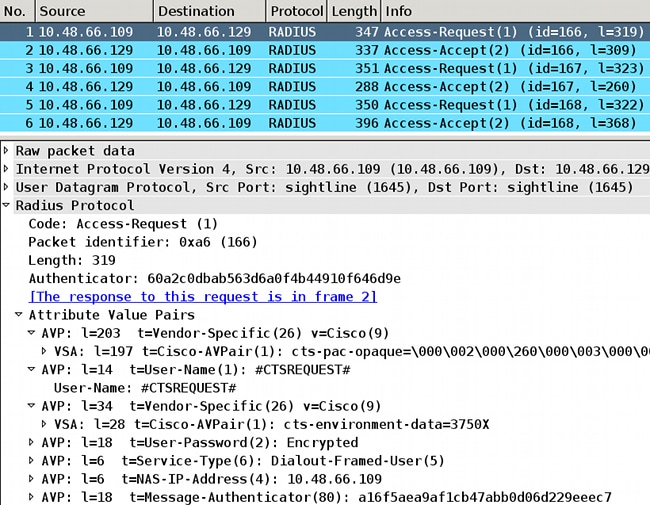
On the 3750X, you should see debugs for all three RADIUS responses and the corresponding lists, list details, and the specific SGT-inside list:
bsns-3750-5#debug cts environment-data all
*Mar 1 10:05:07.454: CTS env-data: cleanup mcast SGT table
*Mar 1 10:05:18.057: CTS env-data: Force environment-data refresh
*Mar 1 10:05:18.057: CTS env-data: download transport-type =
CTS_TRANSPORT_IP_UDP
*Mar 1 10:05:18.057: cts_env_data START: during state env_data_complete,
got event 0(env_data_request)
*Mar 1 10:05:18.057: @@@ cts_env_data START: env_data_complete ->
env_data_waiting_rsp
*Mar 1 10:05:18.057: env_data_waiting_rsp_enter: state = WAITING_RESPONSE
*Mar 1 10:05:18.057: env_data_request_action: state = WAITING_RESPONSE
*Mar 1 10:05:18.057: cts_env_data_is_complete: FALSE, req(x0), rec(x0),
expect(x81), complete1(x85), complete2(xB5), complete3(x28B5)
*Mar 1 10:05:18.057: cts_aaa_req_setup: (CTS env-data)Private group appears DEAD,
attempt public group
*Mar 1 10:05:18.057: cts_aaa_req_setup: (CTS env-data)CTS_TRANSPORT_IP_UDP
*Mar 1 10:05:18.057: cts_aaa_req_setup: (CTS env-data)AAA req(x7C3DF10)
*Mar 1 10:05:18.057: cts_aaa_attr_add: AAA req(0x7C3DF10)
*Mar 1 10:05:18.057: username = #CTSREQUEST#
*Mar 1 10:05:18.057: cts-environment-data = 3750X
*Mar 1 10:05:18.057: cts_aaa_req_send: AAA req(0x7C3DF10) successfully sent to AAA.
*Mar 1 10:05:18.083: cts_aaa_callback: (CTS env-data)AAA req(0x7C3DF10)
response success
*Mar 1 10:05:18.083: AAA attr: Unknown type (447).
*Mar 1 10:05:18.083: AAA attr: Unknown type (220).
*Mar 1 10:05:18.083: AAA attr: Unknown type (275).
*Mar 1 10:05:18.083: AAA attr: server-list = CTSServerList1-0001.
*Mar 1 10:05:18.083: AAA attr: security-group-tag = 0000-00.
*Mar 1 10:05:18.083: AAA attr: environment-data-expiry = 86400.
*Mar 1 10:05:18.083: AAA attr: security-group-table = 0001-5.
*Mar 1 10:05:18.083: CTS env-data: Receiving AAA attributes
CTS_AAA_SLIST
slist name(CTSServerList1) received in 1st Access-Accept
slist name(CTSServerList1) created
CTS_AAA_SECURITY_GROUP_TAG - SGT = unicast-unknown-00
CTS_AAA_ENVIRONMENT_DATA_EXPIRY = 86400.
CTS_AAA_SGT_NAME_LIST
table(0001) received in 1st Access-Accept
old name(), gen()
new name(0001), gen(50)
CTS_AAA_DATA_END
*Mar 1 10:05:18.083: cts_env_data WAITING_RESPONSE: during state
env_data_waiting_rsp, got event 1(env_data_received)
*Mar 1 10:05:18.083: @@@ cts_env_data WAITING_RESPONSE: env_data_waiting_rsp ->
env_data_assessing
*Mar 1 10:05:18.083: env_data_assessing_enter: state = ASSESSING
*Mar 1 10:05:18.083: env_data_assessing_action: state = ASSESSING
*Mar 1 10:05:18.083: cts_env_data_is_complete: FALSE, req(x1089), rec(xC83),
expect(x28B5), complete1(x85), complete2(xB5), complete3(x28B5)
*Mar 1 10:05:18.083: cts_env_data ASSESSING: during state env_data_assessing,
got event 3(env_data_incomplete)
*Mar 1 10:05:18.083: @@@ cts_env_data ASSESSING: env_data_assessing ->
env_data_waiting_rsp
*Mar 1 10:05:18.083: env_data_waiting_rsp_enter: state = WAITING_RESPONSE
*Mar 1 10:05:18.083: env_data_request_action: state = WAITING_RESPONSE
*Mar 1 10:05:18.083: cts_env_data_is_complete: FALSE, req(x1089), rec(xC83),
expect(x28B5), complete1(x85), complete2(xB5), complete3(x28B5)
*Mar 1 10:05:18.083: cts_aaa_req_setup: (CTS env-data)Private group appears DEAD,
attempt public group
*Mar 1 10:05:18.083: cts_aaa_req_setup: (CTS env-data)CTS_TRANSPORT_IP_UDP
*Mar 1 10:05:18.083: cts_aaa_req_setup: (CTS env-data)AAA req(x792FFD0)
*Mar 1 10:05:18.083: cts_aaa_attr_add: AAA req(0x792FFD0)
*Mar 1 10:05:18.091: username = #CTSREQUEST#
*Mar 1 10:05:18.091: cts-server-list = CTSServerList1
*Mar 1 10:05:18.091: cts_aaa_req_send: AAA req(0x792FFD0) successfully sent to AAA.
*Mar 1 10:05:18.099: cts_aaa_callback: (CTS env-data)AAA req(0x792FFD0)
response success
*Mar 1 10:05:18.099: AAA attr: Unknown type (447).
*Mar 1 10:05:18.099: AAA attr: Unknown type (220).
*Mar 1 10:05:18.099: AAA attr: Unknown type (275).
*Mar 1 10:05:18.099: AAA attr: server-list = CTSServerList1-0001.
*Mar 1 10:05:18.099: AAA attr: server = c40a15a339286ceac28a50dbbac59784:
10.48.66.129:1812.
*Mar 1 10:05:18.099: CTS env-data: Receiving AAA attributes
CTS_AAA_SLIST
2nd Access-Accept slist name(CTSServerList1), gen(0001)
CTS_AAA_SERVERS
server (c40a15a339286ceac28a50dbbac59784:10.48.66.129:1812) added
CTS_AAA_DATA_END
*Mar 1 10:05:18.099: cts_env_data WAITING_RESPONSE: during state
env_data_waiting_rsp, got event 1(env_data_received)
*Mar 1 10:05:18.099: @@@ cts_env_data WAITING_RESPONSE: env_data_waiting_rsp ->
env_data_assessing
*Mar 1 10:05:18.099: env_data_assessing_enter: state = ASSESSING
*Mar 1 10:05:18.099: env_data_assessing_action: state = ASSESSING
*Mar 1 10:05:18.099: cts_env_data_is_complete: FALSE, req(x108D), rec(xC87),
expect(x28B5), complete1(x85), complete2(xB5), complete3(x28B5)
*Mar 1 10:05:18.099: cts_env_data ASSESSING: during state env_data_assessing,
got event 3(env_data_incomplete)
*Mar 1 10:05:18.099: @@@ cts_env_data ASSESSING: env_data_assessing ->
env_data_waiting_rsp
*Mar 1 10:05:18.099: env_data_waiting_rsp_enter: state = WAITING_RESPONSE
*Mar 1 10:05:18.099: env_data_request_action: state = WAITING_RESPONSE
*Mar 1 10:05:18.099: cts_env_data_is_complete: FALSE, req(x108D), rec(xC87),
expect(x28B5), complete1(x85), complete2(xB5), complete3(x28B5)
*Mar 1 10:05:18.099: cts_aaa_req_setup: (CTS env-data)Using private server group
*Mar 1 10:05:18.099: cts_aaa_req_setup: (CTS env-data)CTS_TRANSPORT_IP_UDP
*Mar 1 10:05:18.099: cts_aaa_req_setup: (CTS env-data)AAA req(x7A6C4AC)
*Mar 1 10:05:18.099: cts_aaa_attr_add: AAA req(0x7A6C4AC)
*Mar 1 10:05:18.099: username = #CTSREQUEST#
*Mar 1 10:05:18.099: cts-security-group-table = 0001
*Mar 1 10:05:18.099: cts_aaa_req_send: AAA req(0x7A6C4AC) successfully sent to AAA.
*Mar 1 10:05:18.108: cts_aaa_callback: (CTS env-data)AAA req(0x7A6C4AC)
response success
*Mar 1 10:05:18.108: AAA attr: Unknown type (447).
*Mar 1 10:05:18.108: AAA attr: Unknown type (220).
*Mar 1 10:05:18.108: AAA attr: Unknown type (275).
*Mar 1 10:05:18.108: AAA attr: security-group-table = 0001-5.
*Mar 1 10:05:18.108: AAA attr: security-group-info = 0-0-00-Unknown.
*Mar 1 10:05:18.108: AAA attr: security-group-info = ffff-0-00-ANY.
*Mar 1 10:05:18.108: AAA attr: security-group-info = 2-0-00-VLAN10.
*Mar 1 10:05:18.108: AAA attr: security-group-info = 3-0-00-VLAN20.
*Mar 1 10:05:18.108: CTS env-data: Receiving AAA attributes
CTS_AAA_SGT_NAME_LIST
table(0001) received in 2nd Access-Accept
old name(0001), gen(50)
new name(0001), gen(50)
CTS_AAA_SGT_NAME_INBOUND - SGT = unicast-unknown-00
flag (128) server name (Unknown) added
name (0001), request (1), receive (1)
Setting SG Name receving bit CTS_ENV_DATA_SGT_NAME_ENTRY on
CTS_AAA_SGT_NAME_INBOUND - SGT = unicast-default-00
flag (128) server name (ANY) added
name (0001), request (1), receive (1)
Setting SG Name receving bit CTS_ENV_DATA_SGT_NAME_ENTRY on
CTS_AAA_SGT_NAME_INBOUND - SGT = 2-00
flag (128) server name (VLAN10) added
name (0001), request (1), receive (1)
Setting SG Name receving bit CTS_ENV_DATA_SGT_NAME_ENTRY on
CTS_AAA_SGT_NAME_INBOUND - SGT = 3-00
flag (128) server name (VLAN20) added
name (0001), request (1), receive (1)
Setting SG Name receving bit CTS_ENV_DATA_SGT_NAME_ENTRY on
CTS_AAA_DATA_END
*Mar 1 10:05:18.108: cts_env_data WAITING_RESPONSE: during state
env_data_waiting_rsp, got event 1(env_data_received)
*Mar 1 10:05:18.108: @@@ cts_env_data WAITING_RESPONSE: env_data_waiting_rsp ->
env_data_assessing
*Mar 1 10:05:18.108: env_data_assessing_enter: state = ASSESSING
*Mar 1 10:05:18.108: env_data_assessing_action: state = ASSESSING
*Mar 1 10:05:18.116: cts_env_data_is_complete: TRUE, req(x2085), rec(x2C87),
expect(x81), complete1(x85), complete2(xB5), complete3(x28B5)
*Mar 1 10:05:18.116: cts_env_data ASSESSING: during state env_data_assessing,
got event 4(env_data_complete)
*Mar 1 10:05:18.116: @@@ cts_env_data ASSESSING: env_data_assessing ->
env_data_complete
*Mar 1 10:05:18.116: env_data_complete_enter: state = COMPLETE
*Mar 1 10:05:18.116: env_data_install_action: state = COMPLETE
Policy Refresh
The policy refresh is supported only on the switch. It is similar to the environment refresh. These are simply RADIUS Requests and Accepts.
The switch asks for all the ACLs within the default list. Then, for each ACL that is not up-to-date (or does not exist), it sends another request to obtain the details.
Here is an example response when you ask for ICMP-20 ACL:
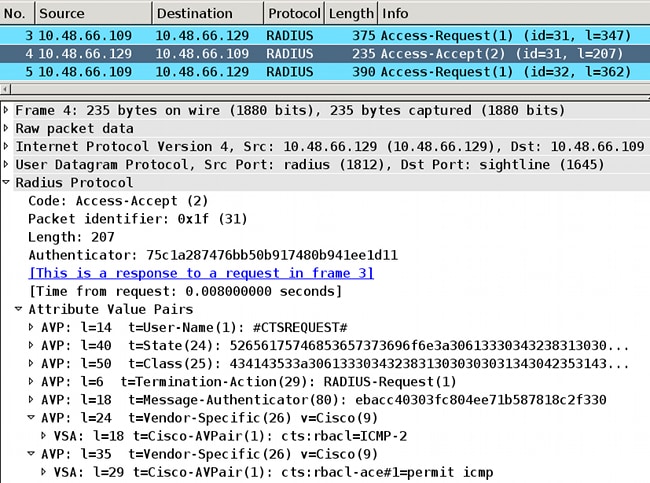
Remember that you must have cts role-based enforcement configured in order to enforce that ACL.
Debugs indicate if there are changes (based on gen ID). If so, you can uninstall the old policy if needed, and install a new one. This includes ASIC programming (hardware support).
bsns-3750-5#debug cts all
Mar 30 02:39:37.151: CTS authz entry: peer(Unknown-2) Receiving AAA attributes
rcv rbacl list: flags: req(81)rcv(0)wait(80)prev(0)install(880)
- SGT = 2-01:VLAN10
- SGT = 2-01:VLAN10
current arg_cnt=8, expected_num_args=11
3rd Access-Accept rbacl received name(ICMP), gen(20)
received_policyp->sgt(2-01:VLAN10)
existing sgt_policy(73FFDB4) sgt(2-01:VLAN10)
RBACL name(ICMP-20)flag(40000000) already exists
acl_listp(740266C) old_acl_infop(0),exist_rbacl_type(0)
CTS_AAA_AUTHORIZATION_EXPIRY = 86400.
CTS_AAA_DATA_END
Mar 30 02:39:37.176: cts_authz_entry_complete_action: Policy download complete -
peer(Unknown-2) SGT(2-01:VLAN10) status(RBACL-POLICY SUCCEEDED)
Mar 30 02:39:37.176: cts_authz_rbacl_uninstall_cb:
Mar 30 02:39:37.176: uninstall cb_ctx:
Mar 30 02:39:37.176: session_hdl = F1000003
Mar 30 02:39:37.176: sgt_policyp = 73FFDB4, sgt=(2-01:VLAN10), magic(BABECABB)
Mar 30 02:39:37.176: ip_version = IPV6
Mar 30 02:39:37.176: src-or-dst = BOTH
Mar 30 02:39:37.176: wait_rbm_install_ip_ver(0)
Mar 30 02:39:37.176: wait_rbm_uninstall_ip_ver(C0000000)
Mar 30 02:39:37.176: cts_authz_rbacl_uninstall_cb:
Mar 30 02:39:37.176: uninstall cb_ctx:
Mar 30 02:39:37.176: session_hdl = F1000003
Mar 30 02:39:37.176: sgt_policyp = 73FFDB4, sgt=(2-01:VLAN10), magic(BABECABB)
Mar 30 02:39:37.176: ip_version = IPV4
Mar 30 02:39:37.176: src-or-dst = BOTH
Mar 30 02:39:37.176: wait_rbm_install_ip_ver(0)
Mar 30 02:39:37.176: wait_rbm_uninstall_ip_ver(40000000)
Mar 30 02:39:37.210: install cb_ctx:
Mar 30 02:39:37.210: session_hdl = F1000003
Mar 30 02:39:37.210: sgt_policyp = 73FFDB4, sgt=(2-01:VLAN10), magic(BABECABB)
Mar 30 02:39:37.210: ip_version = IPV6
Mar 30 02:39:37.210: src-or-dst = SRC
Mar 30 02:39:37.210: wait_rbm_install_ip_ver(C0000000)
Mar 30 02:39:37.210: wait_rbm_uninstall_ip_ver(0)
Mar 30 02:39:37.210: cts_authz_rbacl_install_cb: Waiting for more RBM callback
for remaining IP version(40000000) RBACL policy(73FFDB4) for SGT(2-01:VLAN10)
flag(41400001)
Mar 30 02:39:37.210: cts_authz_rbacl_install_cb:
Mar 30 02:39:37.210: install cb_ctx:
Mar 30 02:39:37.210: session_hdl = F1000003
Mar 30 02:39:37.210: sgt_policyp = 73FFDB4, sgt=(2-01:VLAN10), magic(BABECABB)
Mar 30 02:39:37.210: ip_version = IPV4
Mar 30 02:39:37.210: src-or-dst = SRC
Mar 30 02:39:37.210: wait_rbm_install_ip_ver(40000000)
Mar 30 02:39:37.210: wait_rbm_uninstall_ip_ver(0)
Mar 30 02:39:37.210: cts_authz_rbacl_install_cb: Program RBACL policy(73FFDB4)
for SGT(2-01:VLAN10) flag(41400001) success
SXP Exchange
The SXP update is triggered by the IP device-tracking code that finds the IP address of the device. Then, Short Message Peer-to-Peer (SMPP) protocol is used in order to send the updates. It uses TCP option 19 for authentication, which is the same as Border Gateway Protocol (BGP). The SMPP payload is not encrypted. Wireshark does not have a proper decoder for the SMPP payload, but it is easy to find data inside it:

- The first one, c0 a8 01 c8, is 192.168.1.200 and has tag 2.
- The second one, c0 a8 02 c8, is 192.168.2.200 and has tag 3.
- The third one, c0 a8 0a 02, is 192.168.10.2 and has tag 4 (this one was used in order to test phone SGT=4)
Here are some debugs on the 3750X after IP device tracking finds the IP address of MS Windows 7:
bsns-3750-5#debug cts sxp message
bsns-3750-5#debug cts sxp internal
bsns-3750-5#debug cts sxp conn
bsns-3750-5#debug cts sxp mdb
bsns-3750-5#debug cts sxp error
Apr 7 00:39:06.874: CTS-SXP-CONN:sxp_process_message_event = CTS_SXPMSG_REQUEST
Apr 7 00:39:06.874: CTS-SXP-CONN:sxp_process_request CTS_SXPMSG_REQ_CONN_NVGEN
Apr 7 00:39:06.874: CTS-SXP-CONN:cts_get_next_sxpconn_cli
Apr 7 00:39:06.874: CTS-SXP-CONN:cts_get_next_sxpconn_cli
Apr 7 00:39:06.874: CTS-SXP-INTNL:sxp_process_request boolean set
Apr 7 00:39:06.874: CTS-SXP-INTNL:sxp_send_request set boolean after
Apr 7 00:40:05.418: CTS-SXP-CONN:is_cts_sxp_rf_active
Apr 7 00:40:05.418: CTS-SXP-MDB:sxp_export_ipsgt_change 192.168.1.200/32 add 1
Here are the corresponding debugs on the ASA:
bsns-asa5510-17# debug cts sxp all
%ASA-7-776018: CTS SXP: Binding 192.168.1.200->2:VLAN10 from peer 192.168.1.10
(instance 1) added in SXP database.
%ASA-7-776019: CTS SXP: Binding 192.168.1.200->2:VLAN10 added. Update binding
manager.
%ASA-6-776251: CTS SGT-MAP: Binding 192.168.1.200->2:VLAN10 from SXP added to
binding manager.
%ASA-7-776014: CTS SXP: SXP received binding forwarding request (add) binding
192.168.1.200->2:VLAN10.
In order to see more debugs on the ASA, you can enable the debugging verbosity level:
bsns-asa5510-17# debug cts condition level detail
debug cts condition level detail is enable
SGACL on the ASA
After the ASA correctly installs the SGT mappings received by SXP, the security-groups ACL should work fine. When you encounter problems with the mapping, enter:
bsns-asa5510-17# debug cts sgt-map
The ACL with the security-group works exactly the same as it does for the IP address or the user identity. The logs reveal problems, and the exact entry of the ACL that was hit.
Here is a ping from MS Windows XP to MS Windows 7 that shows that packet tracer works correctly:
bsns-asa5510-17# packet-tracer input inside icmp 192.168.2.200 8 0 192.168.1.200
detailed
<output ommitted>
Phase: 2
Type: ACCESS-LIST
Subtype: log
Result: ALLOW
Config:
access-group inside in interface inside
access-list inside extended permit icmp security-group tag 3 any security-group
name VLAN10 any
Additional Information:
Forward Flow based lookup yields rule:
in id=0xaaf2ae80, priority=13, domain=permit, deny=false
hits=185, user_data=0xaa2f5040, cs_id=0x0, use_real_addr, flags=0x0,
protocol=1
src ip/id=0.0.0.0, mask=0.0.0.0, icmp-type=0, tag=3:VLAN20
dst ip/id=0.0.0.0, mask=0.0.0.0, icmp-code=0, tag=2:VLAN10, dscp=0x0
input_ifc=inside, output_ifc=any
<output ommitted>
Related Information
Revision History
| Revision | Publish Date | Comments |
|---|---|---|
1.0 |
04-Sep-2013 |
Initial Release |
Contact Cisco
- Open a Support Case

- (Requires a Cisco Service Contract)
 Feedback
Feedback